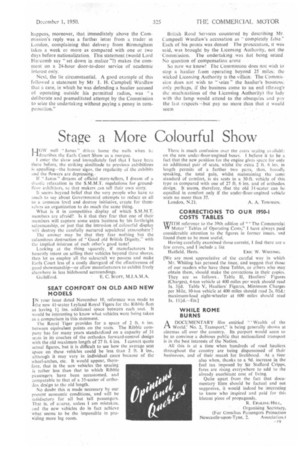Stage a More Colourful Show
Page 61

If you've noticed an error in this article please click here to report it so we can fix it.
UOW well "Janus " drives home the nails when 11.-: I 'describes the Earls Court .Show as a morgue.
I enter the show and immediately feel that I have been there before, the striking similitude to previous exhibitions is appalling--the banner signs, the regularity of the exhibits and the flowers are depressing.r
If " Janus" dreams of official story-tellers, I dream of a drastic relaxation in the S.M.M.T. regulations for groundfloor exhibitors, so that makers can tell their own story.
It seems beyond belief that the very people who have so much to say about Governmental attempts to reduce us all to a common level and destroy initiative, create for themselves an organization to do much the same thing.
What is it in competitive display of which S.M.M.T. members are afraid? Is it that they fear that one of their members will capture some extra business by his forthright salesmanship, or just that the intrusion of colourful display will destroy the carefully nurtured sepulchral atmosphere ?
The answer may be that they fear nothing but the calamitous destruction of " Good old British Dignity," with the implied Mistrust of each other's good taste!
Looking at the thing squarely, if manufacturers be honestly intent on selling their vehicles beyond these shores. then let us employ all the saleseraft we possess and make Earls Court less of a costly disregard of the effectiveness of 'mod showmanship—or allow manufacturers to exhibit freely elsewhere in less hidebound surroundings.
Guildford. E. C. Scorr, M.I.A.M.A.
SEAT COMFORT ON OLD AND NEW MODELS
TN your issue dated November 10, reference was made to ithe new 4I-seater Leyland Royal Tigers for the Ribble fleet as having I ins, additional space between each seat. It would be interesting to know what vehicles were being taken as a comparison in this statement. The Royal Tiger provides for a space of 2 ft. 6 ins. between equivalent points on the scats. The Ribble company has for many years standardized on a capacity of 31 seats in its coaches of the orthodox forward-control design with the old maximum length of 27 ft. 6 ins. I cannot quote actual figures, but it is difficult to see how the average seat space on these vehicles could be less than 2 ft. 8 'ins., although it may vary in individual cases because of the wheel-arches, etc. it would appear, therefore, that in the new vehicles the spacing is rather less than that to which Ribble passengers have been accustomed, and comparable to that of a 35-seater of orthoJos design to the old length.
No doubt this is made necessary by our present economic conditions, and will be satisfactory for all but tall passengers. That is, of course, unless 1 am mistaken, and the new vehicles do in fact achieve what seemsto be the impossible in providing more leg room. There is much confusion user the estra seating astilabl on the new under-floor-engined buses". I believe it to be a fact that the new position for the engine gives space for only an additional pair of seats, whilst the extra 2 ft. 6 ins, in length permits of a further two pairs, thus, btu:idly speaking, the total gain, whilst maintaining the same standard of comfort, is six seats in a 30-ft. vehicle of this type as compared with one of 27 ft. 6 ins, and of orthodox design. It seems, therefore, that the old 31-seater can be equalled in comfort only if the under-floor-engined vehicle seats no more than 37.
London, N.21. A. A. TowNsiN.
CORRECTIONS TO OUR 1950-1 COSTS TABLES
WITH reference to the 39th edition of "' The Commercial W Motor' Tables of Operating Costs," I have always paid considerable attention to the figures in former issues, and found them to be most useful.
Having carefully examined those eurreht, I find there are a few errors, and I include a list Hatfield, Herts. ERIC W. WHITING.
[We are most appreciative of the careful way in which Mr. Whiting has perused the issue, and suggest that those of our readers who have these Tables, or others who may obtain them, should make the corrections in their copies. They arc as follows_ Table 11, Hauliers' Figures (Charges), 4-ton vehicle at 400 miles per week should read Is. 30. Table V, Hauliers' Figures, Minimum Charges per Mile, I0-ton vehicle at 400 miles should read 2s. maximum-load eight-wheeler at 600 miles should read is.
WHILE ROME BURNS
A DOCUMENTARY film entitled "' Wealth of the in. World.' No. 2, Transport," is being generally shown at cinemas all over the country. Its purport would seem to be to convince a dubious public that nationalized transport is in the best interests of the Nation.
All this is at a time when hundreds of road hauliers
throughout the country are being dispossessed of their businesses, and of their mean for livelihood. At a time also when, thanks to a 9d. increase in the fuel tax imposed by Sir Stafford Cripps, fares are rising everywhere to add to the already exorbitant cost of living.
Quite apart from the fact that docu mentary films should be factual and not suggestive, it would indeed be interesting to know who inspired and paid for this blatant piece of propaganda,
R. ERSKINI.L.HILL, Organising Secretary,
(For Omnibus Passengers Protection
Newcastle-upon-Tyne, 2. Association.)












































































































